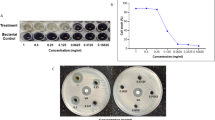Abstract
Streptococcus pyogenes biofilms tend to exhibit significant tolerance to antimicrobials during infections. We screened coral-associated actinomycetes (CAA) for antibiofilm activity against different biofilm forming M serotype of Streptococcus pyogenes. Actinomycetes isolated from the mucus of the coral Acropora digitifera were screened for antibiofilm activity against S. pyogenes biofilms wherein several isolates clearly demonstrated antibiofilm activity. The biofilm inhibitory concentrations (BICs) and the sub-BICs (1/2 and 1/4 BIC) of the extracts significantly prevented biofilm formation up to 60–80%. The extract of Streptomyces akiyoshinensis (A3) displayed efficient antibiofilm activity against all the biofilm forming M serotypes. All the five extracts efficiently reduced the cell surface hydrophobicity (a crucial factor for biofilm formation in S. pyogenes) of three M types and thus may inhibit biofilm formation. CAA represent an interesting source of marine invertebrates-derived antibiofilm agents in the development of new strategies to combat Streptococcal biofilms.



Similar content being viewed by others
References
Akiyama H, Morizane S, Yamasaki O, Oono T, Iwatsuki K (2003) Assessment of Streptococcus pyogenes microcolony formation in infected skin by confocal laser scanning microscopy. J Dermatol Sci 32:193–199
Baldassarri L, Creti R, Recchia S, Imperi M, Facinelli B, Giovanetti E, Pataracchia M, Alfarone G, Orefic G (2006) Therapeutic failures of antibiotics used to treat macrolide-susceptible Streptococcus pyogenes infections may be due to biofilm formation. J Clin Microbiol 44:2721–2727
Clinical and Laboratory Standards Institute (2006) Methods for dilution antimicrobial susceptibility test for bacteria that grow aerobically; approved standard, 7th edn. Clinical and Laboratory Standards Institute document M7–A7. Clinical and Laboratory Standards Institute, Wayne, PA
Conley J, Olson ME, Cook LS, Ceri H, Phan V, Davies HD (2003) Biofilm formation by group A Streptococci: is there a relationship with treatment failure. J Clin Microbiol 41:4043–4048
Courtney HS, Ofek I, Penfound T, Nizet V, Pence MA, Kreikemeyer B, Podbielbski A, Hasty DL, Dale JB (2009) Relationship between expression of the family of M proteins and lipoteichoic acid to hydrophobicity and biofilm formation in Streptococcus pyogenes. PloS One 4:e4166
Doyle RJ, Rosenberg M (1990) Microbial cell surface hydrophobicity. American Society for Microbiology, Washington, DC, p 425
Hall-Stoodley L, Costerton JW, Stoodley P (2004) Bacterial biofilms: from the natural environment to infectious diseases. Nat Rev Microbiol 2:95–108
Hill RT (2004) Microbes from marine sponges: a trove of biodiversity of natural products discovery. In: Bull AT (ed) Microbial diversity and bioprospecting. ASM Press, Washington, DC, pp 177–190
Jensen PR, Mincer TJ, Williams PG, Fenical W (2005) Marine actinomycete diversity and natural product discovery. Anton Van Leeuwenhoek 87:43–48
Kuhn SM, Preiksaitis J, Tyrrell GJ, Jadavji T, Church D, Davies HD (2001) Evaluation of potential factors contributing to microbiological treatment failure in Streptococcus pyogenes pharyngitis. Can J Infect Dis 12:33–39
Lampert Y, Kelman D, Dubinsky Z, Nitzan Y, Hill RT (2006) Diversity of culturable bacteria in the mucus of the Red Sea coral Fungia scutaria. FEMS Microbiol Ecol 58:99–108
Lampert Y, Kelman D, Nitzan Y, Dubinsky Z, Behar A, Hill RT (2008) Phylogenetic diversity of bacteria associated with the mucus of Red sea corals. FEMS Microbiol Ecol 1:1–17
Lembke C, Podbielski A, Hidalgo-Grass C, Jonas L, Hanski E, Kreikemeyer B (2006) Characterization of biofilm formation by clinically relevant serotypes of group A Streptococci. Appl Microbiol Biotechnol 72:2864–2875
Limsuwan S, Voravuthikunchai SP (2008) Boesenbergia pandurata (Roxb.) schltr., Eleutherine americana merr. and Rhodomyrtus tomentosa (Aiton) Hassk. as antibiofilm producing and antiquorum sensing in Streptococcus pyogenes. FEMS Immunol Med Microbiol 5:429–436
Macris MH, Hartman N, Murray B, Klein RF, Roberts RB, Kaplan EL, Horn D, Zabriskie JB (1998) Studies of the continuing susceptibility of group A streptococcal strains to penicillin during eight decades. Pediatr Infect Dis J 17:377–381
Nithyanand P, Pandian SK (2009) Phylogenetic characterization of culturable bacterial diversity associated with the mucus and tissue of the coral Acropora digitifera from Gulf of Mannar. FEMS Microbiol Ecol 69:384–394
Rasooli I, Fakoor MH, Yadegarinia D, Gachkar L, Allameh A, Rezaei MB (2008) Antimycotoxigenic characteristics of Rosmarinus officinalis and Trachyspermum copticum L. essential oils. Int J Food Microbiol 122:135–139
Stoodley P, Sauer K, Davies DG, Costerton JW (2002) Biofilms as complex differentiated communities. Annu Rev Microbiol 56:187–209
Sun D, Courtney HS, Beachey EH (1988) Berberine sulfate blocks adherence of Streptococcus pyogenes to epithelial cells, fibronectin, and hexadecane. Antimicrob Agents Chemother 32:1370–1374
Swiatlo E, Champlin FR, Holman SC, Wilson WW, Watt JM (2002) Contribution of choline-binding proteins to cell surface properties of Streptococcus pneumoniae. Infect Immun 70:412–415
You J, Xue X, Cao L, Lu X, Wang J, Zhang L, Zhou SV (2007) Inhibition of Vibrio biofilm formation by a marine actinomycete strain A66. Appl Microbiol Biotechnol 76:1137–1144
Author information
Authors and Affiliations
Corresponding author
Electronic Supplementary Material
Below is the link to the electronic supplementary material.
Rights and permissions
About this article
Cite this article
Nithyanand, P., Thenmozhi, R., Rathna, J. et al. Inhibition of Streptococcus pyogenes Biofilm Formation by Coral-Associated Actinomycetes. Curr Microbiol 60, 454–460 (2010). https://doi.org/10.1007/s00284-009-9564-y
Received:
Accepted:
Published:
Issue Date:
DOI: https://doi.org/10.1007/s00284-009-9564-y




